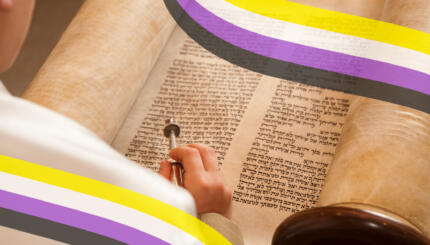The bar/bat mitzvah child’s role in the service varies according to the abilities of the child and the expectations of both the synagogue and the movement to which it belongs. Because the bar/bat mitzvah ceremony is late in origin, the only real “requirement” is for the child to be called up to the Torah. In more traditional environments, bar mitzvah also marks the time when the young man begins to wear tefillin, or phylacteries, at the daily service.
What Are the Possibilities?
A number of potential roles have evolved for the child during a typical bar/bat mitzvah ceremony.
Aliyah (the blessing over the Torah): The child is called up for the first time to recite the blessings before and after the Torah reading. This aliyah actualizes the child’s new responsibilities in the Jewish community. Girls in some communities celebrate their bat mitzvah at the Shabbat evening service and therefore do not have an aliyah. Traditionalist communities do not call women to the Torah for aliyot (the plural of aliyah). However, even in some very traditional settings, a girl may have an aliyah, although with modified blessings, in the context of an all-women’s prayer group.
Reading from the Torah: The child may chant all or part of the weekly Torah reading, which is divided into seven portions. Although it is traditional for the bar/bat mitzvah to read the final portion, called the maftir (which usually is a repetition of several verses from the seventh portion), children may read more, up to and including the entire Torah portion.
With your help, My Jewish Learning can provide endless opportunities for learning, connection and discovery.
Chanting the haftarah: The child usually chants the haftarah, the weekly prophetic portion, which is associated thematically with the Torah portion. The child also chants the blessings that precede and follow the haftarah reading.
Leading the service: The child may lead one or more parts of the service. On Shabbat mornings, these would include Psukai d’zimrah, the psalms and readings that precede the morning service; Shacharit, the morning service; the Torah service; and Musaf, the additional service. At a Shabbat afternoon bar/bat mitzvah, the child may lead the Mincha (afternoon) and Maariv (evening) services, as well as the havdalah ceremony, which marks the separation between the Sabbath and the weekday.
Delivering a drasha (speech) or d’var Torah (word of Torah): The child often delivers a talk that delves into themes of the Torah portion or the haftarah. Often the child explains why these themes are important in his or her own life. The talks vary in depth according to the child’s level of scholarship and the synagogue’s tradition. The subject matter may also be more wide ranging. In traditional settings, the talk may demonstrate the child’s Talmudic expertise. In liberal settings, the talk may describe a student’s bar/bat mitzvah tzedakah, or social action, project.
Reciting a prayer: A child may offer his or her own prayer or recite a traditional one.
Saying the bar/bat mitzvah “pledge”: In liberal communities, students sometimes recite a pledge to continue their Jewish education.
Leading hamotzi and kiddush: A child may lead the blessings over the bread and wine immediately following the service.
Other Issues
Although the haftarah is traditionally chanted only at the Shabbat morning service, a girl who observes her bat mitzvah on a Friday night will often chant it then. In more traditional environments, the bar mitzvah may be held on a weekday morning to give the child the opportunity to put on tefillin, or phylacteries, for the first time.
For a bat mitzvah in a traditional environment, the girl usually will have no role in the actual congregational service, but may speak to the congregation after the service is over. In a women’s prayer service, she may perform most of the roles listed above.
aliyah
Pronounced: a-LEE-yuh for synagogue use, ah-lee-YAH for immigration to Israel, Origin: Hebrew, literally, "to go up." This can mean the honor of saying a blessing before and after the Torah reading during a worship service, or immigrating to Israel.
bar mitzvah
Pronounced: bar MITZ-vuh, also bar meetz-VAH, Origin: Hebrew, Jewish rite of passage for a 13-year-old boy.
bat mitzvah
Pronounced: baht MITZ-vuh, also bahs MITZ-vuh and baht meetz-VAH, Origin: Hebrew, Jewish rite of passage for a girl, observed at age 12 or 13.
mitzvah
Pronounced: MITZ-vuh or meetz-VAH, Origin: Hebrew, commandment, also used to mean good deed.
Shabbat
Pronounced: shuh-BAHT or shah-BAHT, Origin: Hebrew, the Sabbath, from sundown Friday to sundown Saturday.
Torah
Pronunced: TORE-uh, Origin: Hebrew, the Five Books of Moses.


